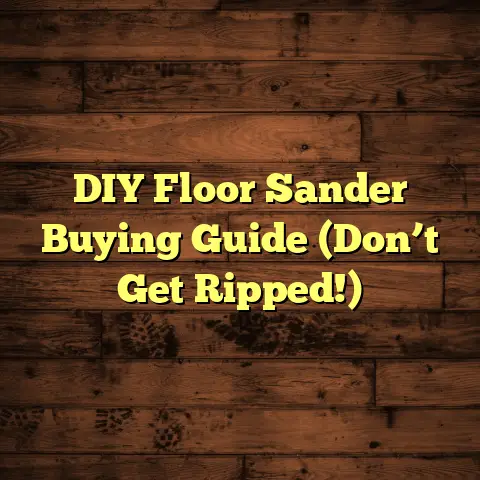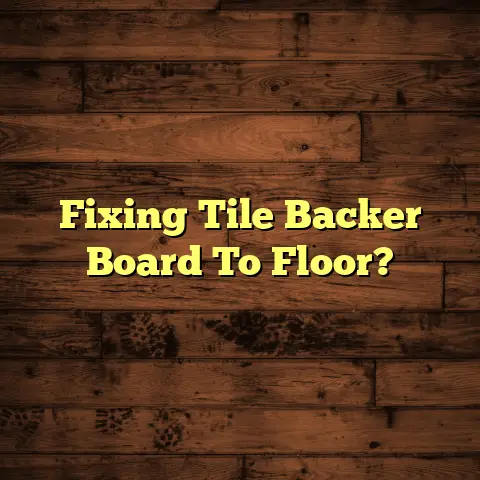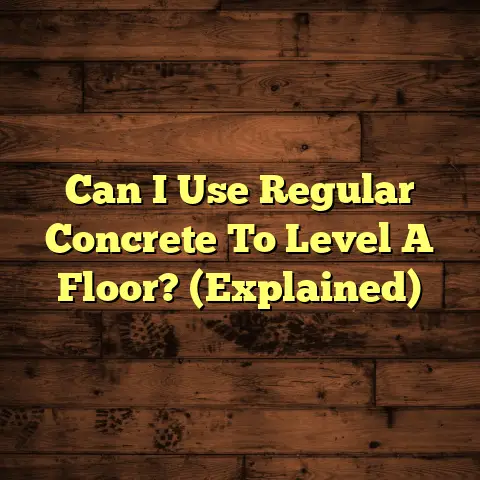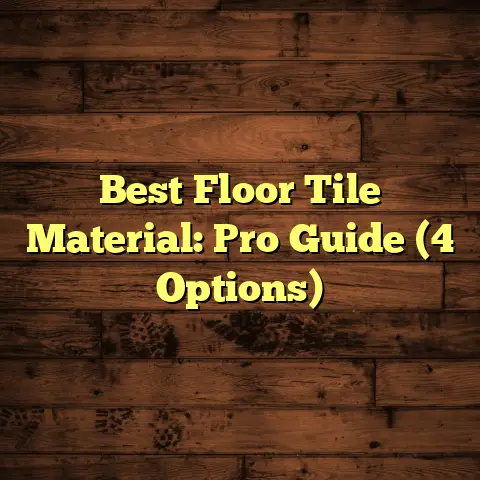Hardwood vs Carpet: Cost Factors? (9 Big Traps!)
Choosing between hardwood and carpet can feel like a huge decision.
It’s not just about how your floors look.
It’s about comfort, how easy they are to clean, and even how they affect your home’s value.
We often focus on the initial price tag, but that’s just the tip of the iceberg.
There are hidden costs lurking beneath the surface that can really sneak up on you.
Think about it: flooring sets the stage for your entire home.
It influences the mood, the style, and even how you feel in a space.
Do you want the warmth and softness of carpet under your feet?
Or the timeless elegance and durability of hardwood?
In this article, I’m going to pull back the curtain and reveal the 9 Big Traps that homeowners often fall into when choosing between hardwood and carpet.
We’ll dive deep into the hidden cost factors that can make or break your budget in the long run.
So, grab a cup of coffee, settle in, and let’s get started!
Section 1: Understanding the Basics
Okay, let’s break down the basics of hardwood and carpet.
Think of this as Flooring 101.
Hardwood: We’re talking solid hardwood, engineered hardwood, and even some exotic options like bamboo (though bamboo isn’t technically wood).
You’ve got your classic oaks, maples, and walnuts, each with its own grain pattern and hardness.
Finishes range from matte to glossy, and you can even get pre-finished or unfinished planks.
Carpet: The world of carpet is vast.
You’ve got your nylons, polyesters, wools, and blends.
Pile styles include plush, berber, frieze, and cut-and-loop.
Each has its own feel and durability.
Then there’s the padding underneath, which is crucial for comfort and longevity.
General Price Ranges: This is where it gets tricky because prices fluctuate based on quality, brand, and location.
Hardwood: Generally, expect to pay anywhere from $8 to $25+ per square foot installed.
Solid hardwood is usually pricier than engineered.Carpet: Carpet can range from $3 to $12+ per square foot installed, depending on the fiber and style.
The padding adds another $1 to $5 per square foot.
Hidden Costs: This is what we’re really here to talk about.
It’s not just the sticker price.
It’s the long-term maintenance, potential repairs, impact on resale value, and even health considerations.
These are the things that can really impact your wallet – and your peace of mind.
Section 2: Trap #1 – Initial Costs vs. Long-Term Investment
This is the biggest trap I see homeowners fall into: focusing solely on the upfront cost.
It’s tempting to go for the cheaper option, but that can backfire in the long run.
Hardwood: The Long Game: Hardwood, especially solid hardwood, is an investment.
It’s more expensive upfront, no doubt.
But it can last for decades, even centuries, with proper care.
You can refinish it multiple times, bringing it back to life and changing its look.
Carpet: The Short-Term Fix: Carpet, on the other hand, typically lasts 5-15 years, depending on the quality and traffic.
It will wear out, stain, and eventually need replacing.
Total Cost of Ownership: Let’s do some quick math.
Say you spend $5,000 on carpet for a room.
You might need to replace it twice over 20 years, bringing your total cost to $15,000+.
Now, imagine you spend $10,000 on hardwood.
You might need to refinish it once or twice over those 20 years, costing you another $2,000-$4,000.
Your total cost is still less than the carpet in the long run!
Case Study: A study by the National Wood Flooring Association (NWFA) found that homes with hardwood flooring tend to have a higher resale value and a faster selling time compared to homes with carpet.
This is a huge factor to consider.
Section 3: Trap #2 – Maintenance and Upkeep
Okay, let’s talk about cleaning.
Because nobody wants to spend all their time scrubbing floors.
Hardwood: Easy Peasy: Hardwood is relatively easy to maintain.
Regular sweeping or vacuuming, plus occasional mopping with a wood-friendly cleaner, is usually all it takes.
You’ll want to avoid excessive moisture, as that can damage the wood.
Carpet: The Struggle is Real: Carpet, on the other hand, is a magnet for dirt, dust, allergens, and spills.
You’ll need to vacuum frequently, and even then, stains can be a nightmare.
Professional cleaning is a must, and even then, some stains might be permanent.
Hidden Costs of Neglect: If you neglect your hardwood, it can become scratched and dull.
Refinishing can be costly, but it’s still cheaper than replacing the entire floor.
If you neglect your carpet, it can become a breeding ground for mold and allergens, leading to health problems and potentially requiring costly remediation.
Pro Tip: I always tell my clients to invest in good quality area rugs, regardless of whether they opt for carpet or hardwood.
Area rugs protect your floors from wear and tear, they add style and personality to your home, and they’re easier to clean or replace than your entire floor.
Section 4: Trap #3 – Resale Value Considerations
This is where things get interesting.
Because your flooring choice can seriously impact what buyers think of your home.
Hardwood: A Buyer Magnet: In general, hardwood is seen as a premium feature.
It adds a touch of elegance and sophistication that buyers love.
It’s also seen as more durable and easier to clean, which are big selling points.
Carpet: A Mixed Bag: Carpet can be a bit of a mixed bag.
Some buyers love the warmth and softness, especially in bedrooms.
But others see it as a potential source of allergens and a sign of wear and tear.
Trends in Real Estate: I’ve noticed a growing trend towards hardwood and hard-surface flooring in general.
Buyers are increasingly looking for homes that are easy to clean and maintain, and hardwood fits the bill perfectly.
Impact on Property Value: According to a study by Realtor.com, homes with hardwood floors tend to sell for a higher price than comparable homes with carpet.
The exact increase varies depending on location and market conditions, but it’s definitely a factor to consider.
Section 5: Trap #4 – Climate and Environment
Where you live can significantly impact how your floors perform.
Hardwood: Humidity’s Nemesis: Hardwood is susceptible to changes in humidity.
In humid climates, it can expand and warp.
In dry climates, it can shrink and crack.
Proper installation and climate control are essential.
Carpet: Mold’s Best Friend: Carpet can trap moisture, especially in humid climates.
This can lead to mold and mildew growth, which can be a serious health hazard.
Hidden Costs of Climate: If you live in a humid climate and choose hardwood, you might need to invest in a dehumidifier to prevent warping.
If you live in a dry climate, you might need to invest in a humidifier to prevent cracking.
If you live in a humid climate and choose carpet, you might need to invest in regular professional cleaning to prevent mold growth.
My Experience: I had a client in Florida who insisted on installing solid hardwood throughout their entire home, even though I warned them about the humidity.
A year later, they called me back complaining about warped floors and mold growth.
It was a costly mistake.
Section 6: Trap #5 – Allergies and Health Considerations
This is a big one, especially if you have allergies or sensitivities.
Hardwood: A Breath of Fresh Air: Hardwood is generally considered to be a healthier option than carpet.
It doesn’t trap dust, pollen, or pet dander as easily, making it easier to keep your home clean and allergen-free.
Carpet: The Allergen Magnet: Carpet can be a haven for allergens.
It traps dust, pollen, pet dander, and mold spores, which can trigger allergies and asthma.
Hidden Costs of Health Issues: If you have allergies or asthma, living in a home with carpet can lead to increased medical expenses, such as doctor visits, allergy medications, and even hospitalizations.
Pro Tip: If you’re set on carpet, look for low-VOC (volatile organic compound) options.
These carpets release fewer harmful chemicals into the air.
Also, invest in a high-quality vacuum cleaner with a HEPA filter.
Section 7: Trap #6 – Aesthetic Longevity
Trends come and go, and your flooring is a major part of your home’s overall aesthetic.
Hardwood: Timeless Appeal: Hardwood is a classic choice that never really goes out of style.
You can always refinish it to update its look, whether you want a lighter or darker stain, a matte or glossy finish.
Carpet: Trend-Driven: Carpet styles can change rapidly.
What’s popular today might look dated in a few years.
Replacing carpet to keep up with trends can be costly.
Hidden Costs of Changing Styles: If you choose a trendy carpet color or pattern, you might find yourself wanting to replace it sooner than you would with a more classic option.
This can add up over time.
My Advice: I always recommend choosing a flooring style that you love and that complements your home’s overall architecture.
Don’t just follow the trends.
Choose something that will stand the test of time.
Section 8: Trap #7 – Installation Costs and Challenges
Installation can be a major factor in the overall cost of your flooring project.
Hardwood: Requires Skill: Hardwood installation is more complex than carpet installation.
It requires specialized tools and skills.
Proper subfloor preparation is crucial to prevent problems down the road.
Carpet: Seemingly Simple: Carpet installation can seem simpler, but it’s still important to hire a professional.
Improper installation can lead to wrinkles, bubbles, and premature wear.
Hidden Costs of DIY: While it might be tempting to save money by installing your own flooring, it can be a costly mistake if you’re not experienced.
You could damage the flooring, void the warranty, or end up with a poorly installed floor that needs to be redone.
Subfloor Surprises: You never know what you’ll find under your old flooring.
You might need to repair or replace the subfloor, which can add to the overall cost.
Section 9: Trap #8 – Environmental Impact and Sustainability
More and more homeowners are concerned about the environmental impact of their choices.
Hardwood: Sustainable Options: Hardwood can be a sustainable choice if it’s sourced from responsibly managed forests.
Look for certifications like the Forest Stewardship Council (FSC).
Carpet: Manufacturing Concerns: Carpet manufacturing can be resource-intensive and generate waste.
However, there are now more eco-friendly options available, such as carpets made from recycled materials.
Hidden Costs of Sustainability: Eco-friendly flooring options can be more expensive upfront.
However, they can also have long-term benefits, such as improved indoor air quality and reduced environmental impact.
Disposal Dilemma: What happens to your old flooring when you replace it?
Hardwood can often be recycled or repurposed.
Carpet, on the other hand, is often sent to landfills.
Section 10: Trap #9 – Personal Lifestyle and Usage
Your lifestyle and how you use your home can significantly impact the longevity and cost-effectiveness of your flooring.
Hardwood: Pet-Friendly (with caveats): Hardwood can be a good choice for pet owners, but it’s important to choose a durable finish that can withstand scratches and accidents.
Carpet: Not Ideal for Pets: Carpet can trap pet hair, odors, and stains.
It’s also more difficult to clean up accidents.
High-Traffic Areas: In high-traffic areas, hardwood is generally more durable and easier to clean than carpet.
Hidden Costs of Lifestyle: If you have pets or children, you might need to replace your carpet more frequently than someone who lives alone.
My Recommendation: Consider your lifestyle and how you use your home when choosing your flooring.
If you have pets or children, choose a durable and easy-to-clean option.
If you have allergies, choose a flooring that doesn’t trap allergens.
Conclusion
Choosing between hardwood and carpet is a big decision, and it’s important to look beyond the initial price tag.
By understanding the 9 Big Traps we’ve discussed, you can make an informed decision that will save you money and headaches in the long run.
Remember to consider the long-term value, maintenance requirements, impact on resale value, climate, health considerations, aesthetic longevity, installation costs, environmental impact, and your personal lifestyle.
Take a holistic view of your flooring options and choose the one that best fits your needs and budget.
Your floors are the foundation of your home, so choose wisely!





